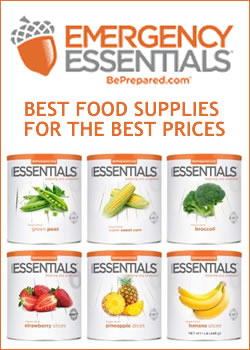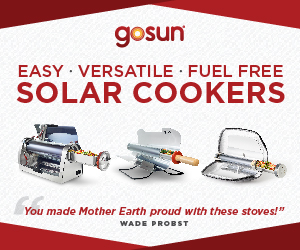- HOME
- Preserving Food
- Storing Fruits and Vegetables
Round Out Your Basic Food Storage With Fruits & Vegetables
Fruit and vegetable storage not only adds variety to the basics of wheat, oats, and rice, but provides the nutrition needed for a well-rounded food storage program.
Fruits can also satisfy that sweet tooth without the calories and sugar contained in most desserts.
Invest in emergency food storage now and enjoy peace of mind for the next 25 years. Don't miss out on the savings!
Three ways to add produce to your food storage:
- Grow your own
- Purchase produce from a local farmer or market
- Purchase commercially preserved fruits and vegetables, either canned, frozen, or freeze dried.
Growing Your Own Fruits and Vegetables
I HIGHLY recommend learning to grow your own fruits and vegetables — before a crisis so you are confident that you can do it.
I love fresh garden tomatoes. No matter how few plants I plant, I always have enough to share. (I have been called the "tomato lady" by friends.) Plant a few among your flowers or bushes. You won't be sorry.
If you love fruits, planting a fruit tree can take a couple of years to produce a good crop. But strawberries are prolific and usually produce a few the first year. I LOVE raspberries but they also take a year or two to produce. But when they are mature enough, you will have plenty.
Vegetables can be grown in very small spaces like a container garden or square foot garden, which allows you to grow a LOT of veggies in a small space.
If you really don't have space for fruit trees and vines, check your local farmer's markets for a great place to buy fresh fruits and vegetables to can, freeze, or dehydrate.
Dehydrated Foods
Dehydrated fruit makes delicious snacks using bananas, grapes, apples, apricots or any other fruit that you like.
Dehydrated vegetables are great to have in your storage to add to soups/stews. Items such as dehydrated onions can save you time and hassle (and tears!) in your everyday cooking.
If you don’t want to go through the hassle of dehydrating foods on your own, you can purchase them online or at various retail stores.
Canned Fruits & vegetables

Put 'em Up!: A Comprehensive Home
Preserving Guide for the Creative
Cook, from Drying and
Freezing to Canning and Pickling
Can your own foods such as salsa, pie fillings, applesauce, juice, spaghetti sauce, almost any fruit or vegetable, pickles, all sorts of jams and jellies, etc.
If you can get fresh fruits/vegetables for free or at a significant discount, then canning them yourself can save you a LOT of money over cans from the store.
Home-bottled foods have fewer preservatives, taste better, and you can adjust the amounts of sugar you use to fit your family’s preferences. For these reasons, I feel like it is worth my time and effort to can them even if I have to purchase the produce.
Bottling can be a fun bonding experience with friends/family and is a great way to build your whole year's supply of items at the same time.
If you choose to purchase cans of fruits and vegetables, you can either purchase an extra few cans each time you shop until you have built up your year's supply or stock up when there are good sales.
Frozen Foods
If you have freezer space, frozen fruits and vegetables are a good choice. In case of a water shortage, which you would need a lot of for dehydrated foods, having a freezer full of food is handy.
Freezing produce takes much less time and preparation than home bottling, and can often be done using less sugar or other preservatives, however, storage shelf life is usually shorter for optimum nutrition - about 6-9 months.
If you don’t have a garden and fruit trees in your own yard, check your area for locally grown fresh produce to purchase by the bushel to freeze. Another option is to buy bags of frozen fruits and vegetables from a Sam's Club or Costco in large packages. Also, watch for sales and coupons to save money.
Freeze Dried Fruits and Vegetables:
A good supply of freeze dried fruits and vegetables is important for my food storage. Not just because they have a 25+ year shelf life, but they are extremely convenient and easy to use, especially in a crisis. They can be eaten right out of the can or reconstituted quickly. Throw a couple of handfuls of vegetables into your soup for dinner - too easy!
Think they're expensive? Think again — and do your own calculations. I did a comparison for you here. Try some for yourself.














